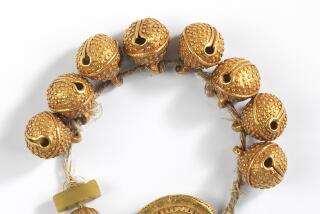Space jewelry? Egyptian bead likely came from meteorite, study says
Did ancient Egyptians prize meteorites so much that they turned them into jewelry? A new study of a 5,000-year-old iron bead hints that the rocky fragments that fell from the sky may have held a special place in the ancient civilization.
The findings published in the journal Meteoritics and Planetary Science center around one of the small, tube-shaped beads pulled from tombs in the Gerzeh cemetery on the Nile’s western bank, dating from 3600 BC to 3350 BC.
Researchers have long wondered whether the metal in the iron beads had alien origins. Some studies seemed to indicate that the beads were rich enough in nickel to indicate they came from meteorites; later studies contested that claim.
“The celestial or terrestrial origin of ancient Egyptian iron, and when its usage became common are contentious issues, which are subject to debate,” the authors wrote. “Evidence is drawn from many areas, including architecture, language, and belief.”
To tackle the question with high-tech tools, British scientists took a 1.8-centimeter-long bead from Gerzeh tomb 67, then used scanning electron microscopy and an X-ray CT scan to study its structure.
They found that the distribution of fragmented metal and oxide compounds, along with the chemical makeup, closely resembled a well-known pattern of weathered iron meteorite.
This same pattern, the authors noted, has been found in Native American iron beads from the Hopewell burial mounds in Illinois from 400 BC, and similar weathering crops up in two Chinese blades from 1000 BC.
The researchers hinted that meteoric iron may have played an important role in Egyptian culture. About 2,000 years after their studied bead was beaten into shape, a term known as “iron from the sky” began to gain traction, they said.
“Reasons for the creation of this new word at this particular point in time are unknown,” they wrote, “but it is possibly a literal description resulting from the observance of a major event by the Egyptian population.”
The authors pointed out that the tomb of Tutankhamen -- King Tut -- held several nickel-rich items that could potentially be of meteoric origin: A dagger blade, 16 miniature blades and a miniature head rest.
But finding out if that possibility is true would take a similar in-depth analysis, they said.
Twitter/@aminawrite







